- Home
- Kieran Larwood
Freaks Page 19
Freaks Read online
Page 19
And even better, now she had something she had never dreamed possible. She had a family of her own. Maybe not the most conventional or normal, but a family nonetheless.
Sheba picked up her ivory comb and began to run it through her chestnut brown curls, taking out the tangles. She looked out over the rooftops of London and smiled. Everyone always said she had a lovely head of hair.
FLOSSY
Pass the afternoon frolicking or gambolling? Flossy was of two minds.
MONKEYBOY
Not only did hanging in his cage provide Monkeyboy with some much-needed ventilation, it also created the game “Guess Which Swear Word I’ve Just Written in Dribble?”
PLUMPSCUTTLE
Before his main meal of the evening, Mr. Plumpscuttle liked to warm his stomach up with two or three practice dinners first.
MAMA RAT
To most people they were disease-ridden, stinking vermin, but to Mama Rat they were cute little babbies. Yuck.
GIGANTUS
Possibly the most muscly man ever to have written a bodice-ripping romance novel.
BARNEY BILGE
Barney’s father always said a walk in the Thames mud would put hairs on your chest. And several fatal diseases in your bloodstream.
BABA ANISH
Baba Anish was most excited to travel to England, visit London, and spend his nights swimming through septic mud in a giant crab-machine, searching for small children to kidnap.
JEREMIAH SNEEPSNOOD
Winner of “Slimiest Crook in Whitechapel” for the past five years straight.
EVERARD WHITMORE
Doctor Whitmore did so enjoy his Sunday evening strolls through London’s less-well-guarded churchyards.
SHEBA THE WOLFGIRL
Mr. Dickens and Mr. Collins receive a particular fright whilst exploring the peculiarities of Brick Lane.
SISTER MOON
Even after months of trying, Monkeyboy still couldn’t persuade Sister Moon that a stroll through St. James’s Park didn’t require you to be quite so heavily armed.
RAGGETY
Sheba wasn’t sure she believed in reincarnation, but she had a good idea where the soul of Vlad the Impaler might have ended up.
If someone were to ask you to think of Victorian London, the picture that might pop into your head is probably that of a grand, imposing place, full of impressive stone structures like the Houses of Parliament and Big Ben, the South Bank of the River Thames, and the famous Tower Bridge. You might imagine cobblestone streets with throngs of horse-drawn carriages, men in stovepipe hats, women wearing big dresses with lots of lace. Maybe there’s the odd chimney sweep or ragged urchin, with a cloth cap and a cheeky grin, saying things like “Gor blimey, guv’nor” and “Up the apples and pears!”
London Street Urchin
I’m British, and that’s what I used to think, anyway.
While all those elements are actually part of the nineteenth-century monster of a city known as London, they are only a tiny part, and most of them date from the very end of the era. The term “Victorian” refers to the period of time Queen Victoria was on the throne in England: from 1837 to 1901. At sixty-three years, that clocks up as the longest reign of a British monarch in history — though our current queen, Elizabeth, looks like she’s on track to break that record.
Queen Victoria (1819–1901)
So the Victorian period covers a significant amount of time, and an amazing amount of change. This was the era of the Industrial Revolution, when steam power and factories changed the world. Britain and many other countries transformed into hungry, ferocious industrial empires in the space of a few decades, and nowhere was the transformation so impactful than in cities — London, the capital of England, perhaps most of all.
At the start of Victoria’s reign, London was a completely different place. By today’s standards, it would rank as a third-world city, with animals in the streets, mud and grime everywhere, and the hygiene level of your brother’s dirty underpants. There were no iconic buildings apart from St. Paul’s Cathedral and Westminster Abbey. The banks of the River Thames were muddy and thronged with docks and buildings. The river itself was clogged with sewage and rubbish (garbage!). Even the landmark Houses of Parliament — the judicial buildings around Big Ben that are a bit like the British equivalent of the United States Congress — didn’t exist. They were still being rebuilt after a fire destroyed them in 1834.
But change was underway, and by 1851, when Freaks is set, London was beginning its rebirth. The first train stations had begun to appear. Soon train tracks would spread across the metropolis, shoveling the slums out of their path as they went. As hordes of people poured into the city from the countryside and abroad, citizens started to worry about the stench and the disease — and they began to take steps to combat it.
Hopefully the story itself will have already given you a snapshot of what the place was like, but to give it all some historical context, here are a few facts about Victorian London.
THE POOR
If you have ever read Oliver Twist by Charles Dickens, you might have the idea that Victorian society didn’t treat its poor very well. In fact, that book is a bit of an understatement — especially since most orphans didn’t have secret families of rich people running around trying to rescue them!
Had you happened to be one of the many, many unfortunate paupers in London in the mid-1800s, your life would have been miserable, uncomfortable, and disease-ridden. The only bright side is that it would have been very short.
Fifty percent of children didn’t survive to see their fifth birthday. Disease was everywhere, probably because people had no idea back then what germs were, and happily drank water that was pumped straight from the river. Water that was basically raw sewage, with a little mud mixed in for flavor. Ugh.
The mudlarks in Freaks have a very unpleasant job, but they weren’t the most unlucky. Some children went wading through the underground sewers, searching for things they could sell. Others made a living collecting dogs’ droppings for the leather-tanning factories. (Once the leather had been cleaned of hair and fur, it needed to be softened. This was done by mashing it about in a mixture of animal brains, dung, and urine. The smell was delightful.) Children were also forced to sweep chimneys, work in nightmarish factories, and do many other horrible things.
London Street Children
The middle classes had just started to realize how bad things were, thanks to writers like Dickens himself. Some were trying to change the situation by proposing new laws and regulations. But life was still pretty grim if you lived in one of London’s many slums.
CRIME
Because of the horrible conditions, many residents of London had little choice but to try and make a living through dishonest means. The backstreets of the city were full of criminals of every description. Pickpockets, burglars, and muggers were common in the poorer areas, and there was a whole underworld of crime. It even had its own language, known as “The Cant.” Pickpockets were “dippers,” burglars were “dancers,” pistols were “barking irons.” I have put a few samples into the story, if you can spot them.
As for the law, there was a police force. In fact, there were two: one for the old city, which was and still is at the center of London, and which dates back to medieval times, and another for the greater metropolis. Police wore steel-reinforced stovepipe hats and carried wooden ratchet rattles to sound the alarm. If you were caught, the punishments were severe. Hangings were common (and very popular with spectators — literally thousands of people turned up to watch them) and the courts were very fond of “transportation,” which was basically shipping British criminals off to Australia to do hard labor. As the saying goes, out of sight and out of mind.
Victorian Policeman
If you weren’t shipped halfway around the world to t
he penal colony of Australia, there were also places right there in London where you could be locked away. The most famous was Newgate Prison (known as the “Stone Jug”), but there were also huge floating prisons made from old warships moored farther down the Thames.
Despite all this, the police forces were not exactly brilliant. There was so much crime in London, they could barely make a dent. The many slum areas, such as the East End and Seven Dials, were neighborhoods best avoided. Especially at night.
FREAK SHOWS
A city with such a huge, ever-growing population needed entertainment. And since most people were very poor, that entertainment had to be cheap.
Whilst the middle classes had their theatre, opera, and ballet, the working class had to make do with “Penny Gaffs.” These were simple stages in the back rooms of inns, packed to the rafters with audiences who had each paid a penny to enter. The shows usually featured a few acts of very poor quality, but nobody minded much, as, truth be told, they were too busy drinking gin!
Along with these establishments, there were many street performers and singers, the odd juggler or acrobat, and, of course, the freak shows.
In an age long before political correctness, people thought nothing of staring and laughing at those who didn’t appear “normal.” In fact, there was a huge demand for glimpses of the unusual or bizarre. This was nothing new — so-called “freaks” had been appearing at fairs and in traveling shows since the Middle Ages — but for some reason the image of the freak show seems to have become indelibly connected with the Victorian era.
Perhaps the most famous show of the time belonged to the American P.T. Barnum. He traveled the world with his “Greatest Show on Earth,” featuring such acts as Tom Thumb and the Feejee Mermaid. Thumb even performed for Queen Victoria when Barnum visited London in 1845.
A Poster Advertising P.T. Barnum’s London Show
But the real reason for the association between freak shows and Victorian London is, I think, a person named Joseph Merrick. Although you might know him better as the “Elephant Man.”
Merrick is believed to have suffered from the condition now known as Proteus syndrome, which causes skin and bone to grow abnormally. His skull was covered with bony lumps, and his skin became thick and wrinkled, causing people to compare him to an elephant.
The Elephant Man
Like most unfortunates who suffered from medical conditions at the time, there was nothing to be done to help him. He was also unable to work to support himself, and so the only option left was to put himself on display.
He ended up in a sideshow in the Whitechapel district of the city, not very far from the site I chose for the Peculiars’ house. His owner was very unkind to him, but luckily Merrick was spotted by a surgeon from the nearby London Hospital and then given rooms inside the hospital itself. He still had to go on show as a medical curiosity, but his standard of living was much better, and he even became a celebrity of sorts.
Shows like the one Merrick the Elephant Man ended up in were common all over the Western world, right into the twentieth century, but the stereotype of a freak show seems to be rooted in the dark corners of Victorian London.
THE GREAT EXHIBITION
Another completely different kind of spectacle was the one taking place in Hyde Park in 1851. The year before, some very important Victorian gentlemen (led by the Queen’s husband, Prince Albert) decided that it was time Britain did a bit of showing off. They planned an enormous exhibition for countries of the world to display their trade and industries, and set about building a colossal iron-and-glass structure to house it in. The building soon became known as the Crystal Palace, and when it opened, it was an attraction the likes of which had never before been seen. More than six million people came to visit it — some of them traveling on newfangled steam trains for the first time just to get there.
The Crystal Palace
The Great Exhibition was intended to show the power and potential of new industrial technology. But since most of the new technology was British, it was really a chance for Britain to make itself look good. Even so, there were exhibits from all over the world, organized into rooms and galleries for the public to tour. The work that went into the construction and staging of the event was incredible. It even required the invention of the first ever public lavatories.
For the admission price of sixpence, you could see amazing new machinery for farming and manufacturing: contraptions for spinning cloth, making envelopes, and harnessing the power of wind and water. There were samples of minerals and produce from every country, models of buildings and warships — even pictures created from human hair. Because it was an exhibition for business, there were no paintings, but sculptures were somehow allowed. Bronze statues of Adam and Eve stood next to depictions of Queen Victoria and Prince Albert themselves.
Egyptian Court Exhibition
Perhaps the most interesting exhibits were the strangest. There was a machine for tipping you out of bed, a penknife with eighty blades, and a series of miniature scenes from everyday life with stuffed squirrels as the characters. And did I mention the pictures created from human hair?
There was also the famous Koh-i-Noor diamond. As the biggest diamond in the world, it was one of the main attractions. Unfortunately it was a big disappointment, too, because it wasn’t lit very well and didn’t sparkle. After the exhibition, the diamond was re-cut and added to Victoria’s crown jewels.
FARADAY
One of the planners and judges for the Great Exhibition was Michael Faraday, a scientist famous for his research into electricity and electro-magnetism. Whilst he did invent several machines for creating electric motion, I’m afraid the Impulse Generator never actually existed — I just made it up.
Michael Faraday (1791–1867)
In Victorian times, little was known about electricity. Most people considered it a bit of a novelty that could never actually be used for anything worthwhile. In 1851, steam power was the way forward, and nobody thought that electric energy would ever match it.
In another connection to the story, Faraday was very concerned about the pollution in the River Thames. He even wrote a letter to the London Times about it, describing his journey down the pungent river one morning: “The smell was very bad, and common to the whole of the water; it was the same as that which now comes up from the gully-holes in the streets; the whole river was . . . a real sewer.”
The issue soon became a serious one. The river’s stench grew to such epic proportions that the hot summer of 1858 was known as the “Great Stink.” The smell was so bad that the Houses of Parliament, which are located right along the Thames, had to close. It was only then that the government decided to do something about the rampant pollution: The resulting amazing Victorian sewer system still exists today.
That should give you a basic understanding of London at the time of Freaks. Throughout the book, I have tried to be quite accurate with all the background and description, although of course I’ve let my imagination run away when it comes to the story. If you take out all the villains, freaks, clockwork automatons, and anything else that seems a bit improbable, you should be left with a good idea of what Victorian London felt, sounded, and most of all smelt like. A fascinating place to visit in a book, but would you really want to live there?
Huge thanks to Claire and Marek for all their support, and also to everyone at Chicken House, especially my amazing editors Imogen Cooper, Rachel Leyshon, and Christine O’Brien.
Kieran Larwood is a kindergarten teacher on the Isle of Wight, where he lives with his wife and children. Freaks, his debut novel, is the winner of the fourth annual Chicken House/London Times Children’s Fiction Competition. Visit him at: www.kmlarwood.com and follow him on Twitter @kmlarwood.
Text copyright © 2013 by Kieran Larwood
All rights reserved. Published by Chicken House, an imprint of Schol
astic Inc., Publishers since 1920. CHICKEN HOUSE, SCHOLASTIC, and associated logos are trademarks and/or registered trademarks of Scholastic Inc.
www.scholastic.com
First published in the United Kingdom in 2012by Chicken House, 2 Palmer Street, Frome, Somerset BA11 1DS.
www.doublecluck.com
Images on pages 237–247 appear courtesy of: London Street Urchin © Frith Collection/SuperStock; Queen Victoria © iStockphoto; Barefooted Slum Children of London © Getty Images; Victorian Policeman aka “Tom Smith, a well-known peeler” © Getty Images; P. T. Barnum Poster © Advertising Archive/Everett Collection; Joseph Merrick aka the “Elephant Man” © The Royal London Hospital Archives; exterior of the Crystal Palace © SSPL via Getty Images; View of the Egyptian Court inside the Crystal Palace © Time & Life Pictures/Getty Images; Michael Faraday © iStockphoto.
Library of Congress Cataloging-in-Publication Data
Larwood, Kieran.
Freaks / Kieran Larwood. — 1st American ed.
p. cm.
Summary: In Victorian London, a lonely band of misfits trapped in a sideshow decides to put their extraordinary talents to use to solve the mysteries that no one else cares about, starting with the stealing of poor children from the banks of the Thames.

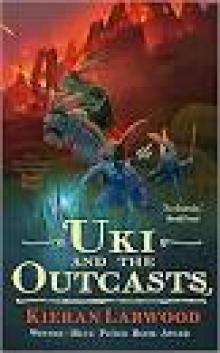 Uki and the Outcasts
Uki and the Outcasts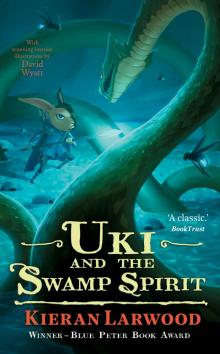 Uki and the Swamp Spirit
Uki and the Swamp Spirit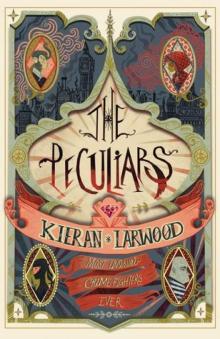 The Peculiars
The Peculiars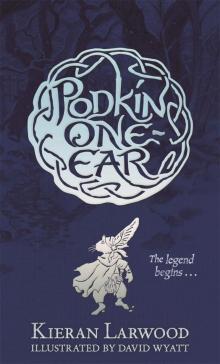 Podkin One-Ear
Podkin One-Ear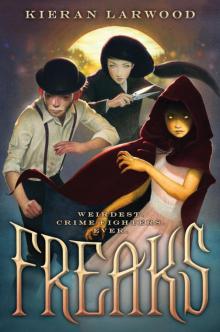 Freaks
Freaks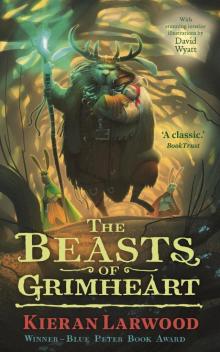 The Beasts of Grimheart
The Beasts of Grimheart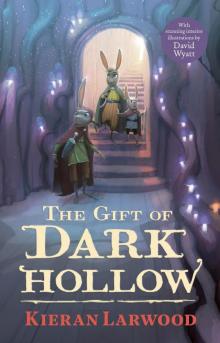 The Gift of Dark Hollow
The Gift of Dark Hollow